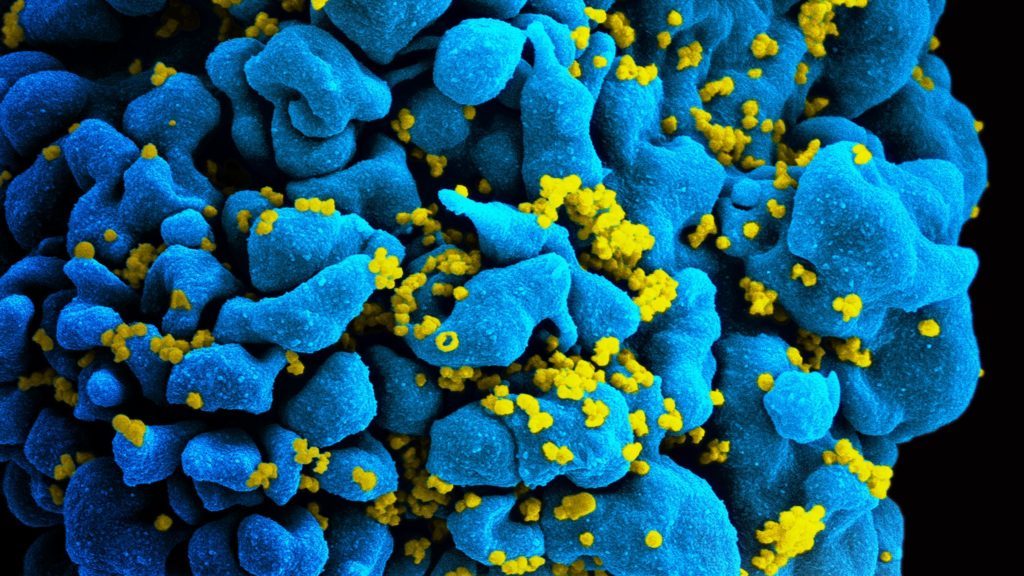Preliminary work in monkeys suggests stem cells can be engineered to help combat the virus
The same kind of DNA tinkering that produced the first FDA-approved gene therapy for cancer has shown hints of suppressing and even eradicating HIV infection in lab animals, scientists have reported. Although the study was small — it tested the genetically engineered “CAR” cells on only two monkeys as well as on cells growing in lab dishes — it suggests that after 30 years of fruitless efforts to come up with an AIDS vaccine there might be a wholly new way to get the immune system to fight HIV infection.

HIV-infected H9 T-cell
“The demonstration here that stem cells can be engineered to respond to AIDS virus-infected cells in an animal model is an impressive first step for harnessing the immune system to target HIV,” said Dr. Bruce Walker, director of the Ragon Institute of MGH, MIT, and Harvard, who in the 1990s did pioneering research on the genetic engineering of immune cells to fight HIV and was not involved in the new study. “The effect at this point is modest, but clearly gives us something to build on.”
To engineer T cells to fight cancer, scientists give them genes that produce surface molecules (the eponymous chimeric antigen receptors, or CARs) able to recognize and attach to their counterparts (antigens) on tumor cells. That antigen-receptor docking activates the CAR-T cells, causing them to kill tumor cells.
To create T cells able to fight HIV, scientists genetically engineered not T cells themselves but stem cells that produce both T cells and other blood cells. The genetic engineering gave the “hematopoietic stem cells” and all of their descendants an HIV-specific CAR: one part of the CAR (called CD4) hunts down and binds the AIDS-causing virus, while an additional surface molecule (called C46) interferes with HIV’s ability to enter a T cell. That allowed T cells to detect viruses without themselves getting infected. It also let them find and destroy HIV-infected cells, which have some of the same T-cell-attracting surface molecules as HIV itself.
The engineered T cells not only destroyed HIV-infected cells in both lab dishes and macaques — they also persisted for more than two years. That suggests that they can “provide long-lasting HIV-killing,” said immunologist Scott Kitchen of the David Geffen School of Medicine at UCLA, who led the study published in PLOS Pathogens. “We think the stem cell approach has greater potential to suppress HIV long-term and even eradicate the virus.”
A clinical trial could begin in a couple of years, said Kitchen, who has been in talks with the private gene therapy company Calimmune and others about developing the approach.
Barriers ahead
Lots of barriers stand between the promising preliminary results and a real-world HIV treatment, however.
For one thing, CAR-T therapy for cancer is priced at nearly $500,000. Anything close to that for HIV treatment is a non-starter in most of the world, especially in poorer countries which have the majority of HIV/AIDS cases; some 17 million of the 36.7 million people living with HIV/AIDS aren’t even receiving the relatively cheap antiretroviral therapy that has saved million of lives.
Price “is the main issue here,” Walker cautioned. “The only real viable role for this kind of therapy would be if it can eliminate the viral reservoir and cure infection, which has not been addressed in this paper. The price tag then could possibly be justified in that case, but given that one can lead a relatively normal life with one pill once a day, it is hard to see how CAR-T cell therapy could be justified just to replace” today’s cheap pills.
Engineered stem cells “would initially be an expensive approach, but would hopefully save the necessity and expense of being on antiretroviral therapy for a lifetime,” Kitchen said. He and his colleagues are working on delivering the engineered cells like a vaccine, perhaps making it affordable.
Another reason for caution is that CAR-T’s against HIV have failed before. The basic idea of engineering immune cells to thwart HIV dates back at least to 1997, when researchers led by Walker showed that a forerunner of CAR-T’s could destroy HIV in lab dishes. But when scientists tested the approach in a small number of patients, the results were disappointing. “They really didn’t do anything,” said Kitchen.
That was probably because HIV killed the CAR-Ts before the CAR-Ts could kill the virus.
Creating CAR stem cells, rather than CAR-T’s, might get around that: engineered stem cells would produce “an endless supply of engineered T cells that continuously attack HIV,” Kitchen said, much like an army with an infinite number of replacement soldiers.
That’s what happened in his macaques. Two received genetically engineered stem cells; two others served as controls. The stem cells burrowed into the bone marrow and produced HIV-killing CAR-T’s for the two years the macaques were studied. The animals experienced no adverse effects, and the CAR-T’s killed infected cells. They did only a so-so job of reducing the number of viruses in the animals.
On the other hand, the killer cells went to sites where HIV tends to replicate and persist at the highest rates, including the lymph system and gastrointestinal tract. Walker called that “impressive,” since it raises the possibility that CAR-Ts might eradicate HIV from where it hides in the body.


 ПОИСК ПО САЙТУ
ПОИСК ПО САЙТУ  поиск по ресурсному центру
поиск по ресурсному центру 



